- Home
- Iain M. Banks
Surface Detail Page 14
Surface Detail Read online
Page 14
Normally, especially given how much amazingly rich experience could be crammed into VRs in general and Afterlives in particular, people went with more modest and neighbourly growth plans in the Real and an extensive though still ultimately limited expansion program in the Virtual.
Because, particularly for those just developing the relevant soul-saving tech, that life in virtual environments beckoned seductively. Deeply immersive and impressive VR was an effectively inevitable adjunct to mind-state transcription technology even if, bizarrely, it hadn’t come into existence before. Each led to and complemented the other.
Only a few species didn’t bother with the soul-transference side at all, some because thanks to their heritage and development they already had something as good or which they judged made it irrelevant, some for specifically religious or philosophical reasons, and some – most – because they were more interested in going for full immortality in the Real and regarded mind-state transcription as a distraction, or even an admission of defeat.
Of course, in any society using this soul-transcription gizmology there was usually a die-hard strand of true believers who insisted that the only afterlife worth bothering about still happened somewhere else, in the true heaven or hell that had always been believed in before all this fangling technology came along, but that was a tough position to hold when at the back of your mind was the niggling doubt that you really might not be saved when the time came, while at the back of everybody else’s mind was a little device that was guaranteed to do precisely that.
The result was that many, many civilisations in the greater galaxy had their own Afterlives: virtual realities maintained in computational or other substrates to which their dead could go and – in some sense at least – live on.
“I can see you now, sir.” (Maneen.)
“Well, space biscuits for you, marine. Switch to LOS.”
“Sir. Sorry. I mean—” (Maneen.)
There was silence for a while. Vatueil watched the big section of bright blue and white planet he could see beyond the curved entrance. The Unknowns – Treat As Enemy were keeping quiet.
The bit of the planet he could see was changing very slowly all the time. He went back and replayed how it had changed since he’d taken up position here. He subtracted the motion component of the place where he was. The place where he was was revolving too but it was revolving slowly and steadily and that made it easy to subtract.
Now he could see that the planet was slowly revolving. Also, the white streaks and whorls which over-lay the blue were changing too, even more slowly. Some of the streaks were widening and some were narrowing and the whorls were spinning about their axes and also shifting across the face of the planet, even allowing for its revolving.
He watched the replay of all this movement many times. It made him feel good. It was different from the way checking his weapons made him feel good. It was like the way watching Xagao’s leg going tumbling off towards the planet had made him feel good. Especially the way its trajectory had curved. It was beautiful.
Beautiful. He thought about this word and decided that it was the right word.
Some Afterlives simply offered everlasting fun for the post-dead: infinite holiday resorts featuring boundless sex, adventure, sport, games, study, exploration, shopping, hunting or whatever other activities especially tickled that particular species’ fancy. Others were as much for the benefit of those still living as the dead themselves, providing societies that had inherited or recently come up with the idea of consulting the ancestors with a practical way of doing just that.
A few were of a more contemplative and philosophic nature than those fixated on general hilarity. Some – and the majority of the more long-established Afterlives – featured a sort of gradual fading-away rather than genuine post-death VR immortality, with the personality of the deceased individual slowly – usually over many generations of time in the Real – dissolving into the general mass of information and civilisational ethos held within the virtual environment.
In some the dead lived much more quickly than those in the Real, in others they lived at the same rate and in others far more slowly. Some even incorporated ways to bring favoured dead individuals back to life again.
And many still featured death; a second, final, absolute death, even within the virtual, because – as it turned out – it was quite a rare species that naturally generated individuals capable of being able, or wanting, to live indefinitely, and those who had lived for a really long time in Afterlives were prone to becoming profoundly, gravely bored, or going catatonically – or screaming – mad. Civs new to the game often went into a sort of shock when the first desperate pleas for true, real death started to emerge from their expensively created, painstakingly maintained, assiduously protected and carefully backed-up Afterlives.
The trick was to treat such entreaties as perfectly natural.
And to let the dead have their way.
He wanted to stay and watch the view of the planet beyond the curved entrance for much longer so that he could see how the whorls and streaks continued to change. Then he could replay the recording again and again. Seeing even more of the planet would be good too. It would be better. Seeing all of the planet would be better still. It would be best.
He realised that he was starting to feel uncomfortable. He wasn’t sure what the cause was at first, then understood that it was because he had stayed too long in the one place after a Recent Combat Event.
He thought about what to do. Nothing had changed or moved recently. It should be safe to move.
He tried asking his Outboard Remote Sensing/Engagement Units what they could sense, but he still didn’t have any of these units. He was supposed to have these things, whatever they were, but he didn’t. It was like another empty magazine that was supposed to be full.
So: Proceed Otherwise. He rose silently on his three articulated legs, senses sweeping all around as his Upper Sensory Dome rose into the space beneath the ceiling (clearance overhead duly reduced from 18.3 to 14.2 metres) and gave him an increased field of view. He kept both Main Weapon Nacelles targeted at the curved entrance. All six Secondary Weapon Pods deployed to cover the rest of the area about him, without him needing to tell them to. He rotated the Upper Weapon Collar to point Nacelle 2 directly behind him, where he judged the least risk was, as it had expended some energy and taken some damage, however nominal.
Still nothing threatening to be sensed. He stepped over the Unidentified High-Solidity Object and moved right and forward, towards the side of the curved entrance that showed the bright blue and white planet. He was moving quietly, at less than optimum speed, so that when his feet connected with the deck they produced minimal vibration. A tipped section of the floor near a long ragged tear in the thick deck material meant that he had to use his weapon pods to balance himself.
Some of the Unidentified Medium-Solidity Objects in the space about him resolved into space- and atmosphere-capable craft. This meant that the place where he was was a hangar. Most of the craft looked chaotically asymmetric, damaged, non-viable.
He could see another Unidentified High-Solidity Object nearer the curved entrance. He moved towards it. The view of the planet became more extensive and made him feel good. Beautiful. It was still beautiful.
Suddenly something moved against the bright white and blue of the planet.
Nobody knew, either, what bright little soul had first hit on the idea of linking up two Afterlives, but given that emerging civilisations were generally quite keen to establish permanent, high-capacity, high-quality and preferably free links with the dataspheres and informational environments of those around them – especially those around them with better tech than they possessed – it had always been going to happen, by accident if not by design. It even benefited the dead of both civilisations, opening up additional new vistas of exciting post-death exper ience, the better for the deceased to resist the regrettable attraction of a second, properly terminal event.
&n
bsp; Linking up all amenable and compatible Afterlives had become something of a craze; almost before the relevant academics could come up with a decent provisional analysis of the phenomenon’s true cultural meaning and implications, practically every corner of the civilised galaxy was linked to every other part by Afterlife connections, as well as by all the other more usual ties of diplomacy, tourism, trade, general nosiness and so on.
So, for many millions of years there had been a network of Afterlives throughout the galaxy, semi-independent from the Real and constantly changing just as the galactic community in the Real changed, with civilisations appearing, developing, steady-stating or disappearing, either changing beyond recognition, relapsing in some way or going for semi-Godhood, sidestepping the material life altogether by opting for the careless indifference that was Subliming.
Mostly, nobody mentioned the Hells.
The moving thing was tiny. Too small to be a person in a suit or even an Outboard Remote Sensing/Engagement Unit, either his or anybody else’s. It was moving at 38.93 metres per second and so was far too slow to be considered kinetic ordinance. It was approximately 3cm by 11cm, round in section, conical aspect to the leading quarter, spinning. He deemed it to be a 32mm mortar shell. He had a lot of high-reliability information on such ordnance. Maximum capability a five kiloton micro-nuke; many variants. It was going to fly directly above where he had been positioned and impact on the bulkhead which had been behind him.
Now his high-telescopic vision apparatus had acquired it, he could see tiny sensory pits on the thing, blurring round as it rotated
(4.2 rps). It flew past him five metres away and started to glitter, giving off range- and Combat Space Topography-sensing laser pulses. None hit him. This was because it had gone past before it activated.
He was still moving, taking one more quiet step as the projectile sailed through the dark space of the hangar. He judged that the ingress of the round meant that an attack might be about to start and that his best choice had become to hunker down here, still five steps away from the Unidentified High-Solidity Object he’d been heading for, opting instead for the partial cover of the nearest Unidentified Medium-Solidity Object, an additional advantage accruing from the fact that a sub-routine assured him his scale and overall shape in hunkered mode would make him look similar to the now Identified Medium-Solidity Object concerned, which was a small, intact but deactivated High-Atmospheric/Low Orbit Planetary Surface Bombardment Unit.
An additional advantage accruing definitely sounded like a good thing. It was almost like an order from inside himself. He’d choose that option. He started hunkering down.
An expert sub-system suggested that should the mortar round detonate where he had been, further additional advantage might be accrued. That sounded good too.
The mortar round was travelling so slowly there was plenty of time to work out exactly where he had been, to target his left upper Light Laser Rifle Unit on the spinning projectile and set himself up for minimal blast-front damage from the direction the round was heading, should it prove to be a micro-nuke.
When it was directly above where he’d been he landed four direct low-power hits on its rear; zero misses or out-splash, which made him feel very good. He whipped the rifle unit back into the armoured nacelle. The mortar round detonated.
Micro-nuke.
The Hells existed because some faiths insisted on them, and some societies too, even without the excuse of over-indulged religiosity.
Whether as a result of perhaps too faithful a transcription – from scriptural assertion to provable actuality – or simply an abiding secular need to continue persecuting those thought worthy of punishment even after they were dead, a number of civilisations – some otherwise quite respectable – had built up impressively ghastly Hells over the eons. These were only rarely linked with other Afterlives, hellish or otherwise, and even then only under strict superveillance, and usually only with the aim of heightening the anguish of the sufferers by subjecting them to torments their own people somehow hadn’t thought of, or the same old ones but inflicted by extra-gruesome alien demons rather than the more familiar home-grown variety.
Very gradually though, perhaps just due to the exact nature of the chance mix the contemporary crop of In-play civilisations represented, a sort of network of Hells – still only partial, and remaining strictly controlled in their interactions – did emerge, and news of their existence and the conditions within them became more widely known.
This led to trouble, in time. Many species and civilisations objected profoundly to the very idea of Hells, no matter whose they were. A lot objected profoundly to the very idea of torture in any event, and the practice of setting up Virtual Environments – traditionally such dazzlingly fabulous realms of unmitigated pleasure – devoted to inflicting pain and suffering on sentient creatures seemed not just wrong but perverse, sadistic, genuinely evil and shamefully, disgracefully cruel. Uncivilised, in fact, and that was not a word such societies bandied about without having thought carefully about its deployment.
The Culture took a particularly dim view of torture, either in the Real or in a Virtuality, and was quite prepared to damage its short- and even – at least seemingly – long-term interests to stop it happening. Such a devoutly censorious, non-pragmatic approach confused people used to dealing with the Culture, but it was a characteristic that had been there since the civilisation’s inception so there was little point in treating it as just a temporary moral fad and waiting for it to pass. As a result, over the millennia, the Culture’s atypically inflexible attitude probably had shifted the whole meta-civilisational moral debate on such matters slightly but significantly to the liberal, altruistic end of the ethical spectrum, that definitive identification of torture with barbarism being perhaps its most obvious mimetic achievement.
There was a predictable mix of responses. A few of the civs hosting Hells simply had a think, took the point and closed them down; generally these were species who had never shown any great enthusiasm for the concept in the first place, their number including some who had only adopted the idea at all because they’d got the erroneous impression it was what all up-and-coming societies did and they hadn’t wanted to appear backward.
Some civilisations just ignored the fuss and said it had nothing to do with anybody else. Others, generally those constitutionally unable to look past any opportunity to go spasming into full High Dudgeon mode, reacted with hysterical bluster, complaining loudly of bullying, ethical imperialism, grossly unwarranted cultural interference and persecution bordering on outright hostility. Some of those, having made their point – and after a decent interval – still proved persuadable that Hells were un acceptable. But not all.
The Hells remained, as did the discord they engendered.
Even so, now and again a civ was effectively bribed out of continuing to host Hells, usually with tech that was a bit beyond it in the normal course of development, though that was a tricky precedent to set in case it encouraged others to try the same trick just to get their hands on the relevant toys, so it remained a strategy that had to be used sparingly.
A few of the more militantly Altruistic civs tried to hack into the Hells belonging to those they saw as their more barbaric peers, to free or destroy the tormented souls within, but that carried its own dangers, and a couple of small wars had resulted.
Eventually, though, a war was agreed upon as the best way to settle the whole dispute. The vast majority of protagonists on both sides agreed they would fight within a controlled Virtuality overseen by impartial arbiters and the winner would accept the result; if the pro-Hell side won there would be no more sanctions or sanctimoniousness from the anti-Hell faction and if the anti-Hellists triumphed then the Hells of the participating adversaries would be shut down.
Both sides thought they would win, the anti-Hell side because they were generally more advanced – an advantage that would be partially reflected in the simmed war – and the pro-Hell side because they w
ere convinced they were the less decadent, more intrinsically warlike side. They also had a couple of hidden assets in the shape of civs who nobody knew had been hosting Hells but who had been persuaded to come on board and who just about (it was decided, after a lengthy legal case) qualified due to the way the relevant agreement had been worded.
Naturally, also, both sides were convinced they had right on their side, not that either was remotely naive enough to think that that had any possible bearing on the outcome whatsoever.
Battle was joined. It duly raged to and fro across the vast virtual conflict spaces within the scrupulously and multiply policed substrates allotted to it, overseen by a people called the Ishlorsinami, a species long notorious for their absolute incorruptibility, spartan lifestyles, near complete lack of humour and a sense of fairness that struck most other normal civs as positively pathological.
But now the war was nearing its end, and, to Vatueil, it looked like his side was going to lose.
It was a micro-nuke, but low-yield. Disposable sensor units deployed on his armoured Main Weapon Nacelles – his upper sensory dome was retracted beneath its armour clamshell – watched what happened. Three sub-munitions had deployed an instant before the main warhead had exploded, fanning downwards towards the floor where he’d been hunkered earlier. It was hard to be sure but he thought that he – the thing he was in – would have survived, had he still been there.
The floor beneath him thudded.
There was much damage where he had been; the bulkhead behind was holed, the ceiling above perforated, bulging upwards, now dipping back down, glowing white and yellow hot as heated supporting elements gave in to the apparent gravity the Abandoned Space Factory’s rotation provided. The Unidentified High-Solidity Object he’d been hiding behind earlier had been partially vaporised/destroyed and shifted across the floor of the hangar until it had impacted with the section of tipped, already-damaged floor.
“Still there!” (Different voice 4.)

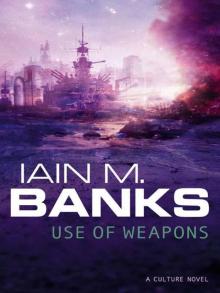 Use of Weapons
Use of Weapons Transition
Transition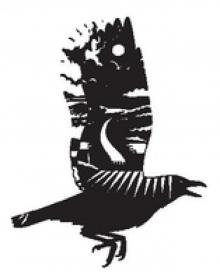 The Crow Road
The Crow Road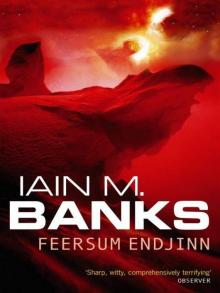 Feersum Endjinn
Feersum Endjinn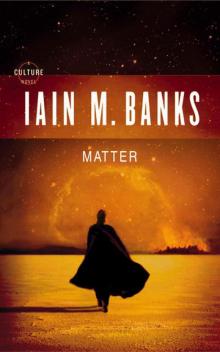 Matter
Matter Surface Detail
Surface Detail The Wasp Factory
The Wasp Factory Consider Phlebas
Consider Phlebas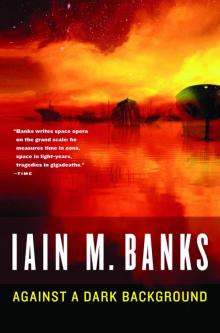 Against a Dark Background
Against a Dark Background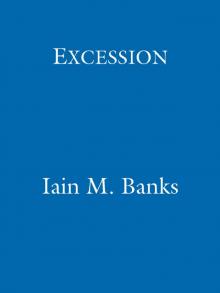 Excession
Excession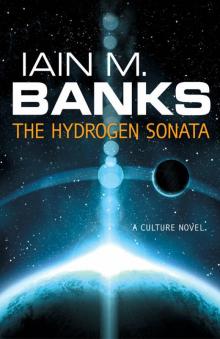 The Hydrogen Sonata
The Hydrogen Sonata The Algebraist
The Algebraist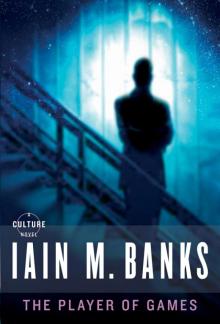 The Player of Games
The Player of Games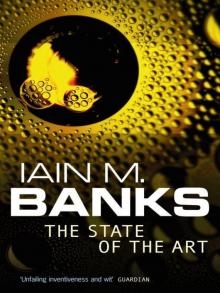 The State of the Art
The State of the Art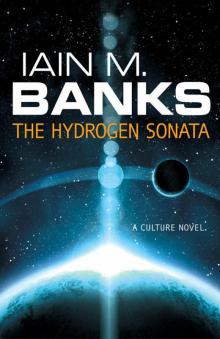 The Hydrogen Sonata c-10
The Hydrogen Sonata c-10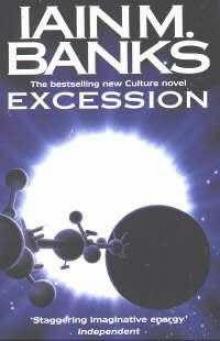 Excession c-5
Excession c-5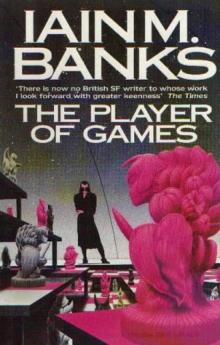 The Player of Games c-2
The Player of Games c-2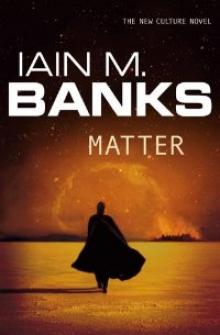 Matter c-8
Matter c-8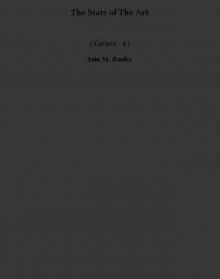 The State of The Art c-4
The State of The Art c-4 Look to Windward c-7
Look to Windward c-7 Consider Phlebas c-1
Consider Phlebas c-1